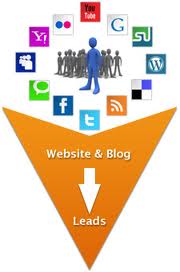Part I: Inbound Internet Marketing — Generating Leads, Building Brands
Getting found by customers.
That’s the goal of inbound “pull” marketing efforts–bringing warm, pre-qualified leads into your sales funnel rather than needing to be constantly reaching outward to cold, uncertain targets.
The DigitalEYE Media team of Orange County Internet marketing specialists always emphasizes the advantages of inbound vs. traditional (outbound “push”) marketing — old-school cold-calling, print and TV advertising, junk mail, non-solicited email and trade shows, which are becoming increasingly more expensive yet ever less effective sales tools.
Inbound marketing is the essence of Internet (Web, online) marketing or e-marketing — promotion of companies and their products or services over the Internet. It involves connecting various marketing methods and channels together to develop a stronger online presence and build a more powerful brand. The main benefits of Internet marketing include a global audience along with lower costs to disseminate information as compared with traditional media.
Companies in all industries have no choice but to compete in today’s online “virtual” cyberspace marketplace, adopting Web marketing strategies to find new customers. The Internet’s ability to provide measurable results make it an ideal venue for coordinated, targeted marketing campaigns with specific commercial goals.
Success begins with steady increases in traffic to a company’s content-rich (text, images, video, audio) website — homepage, landing pages, microsites, newsrooms, blogs and more.
E-commerce websites seek transactions — product purchases.
Business websites seek “conversions” — casual content views or website visits turned into desired actions.
In Internet marketing, conversion rate is the ratio of visitors who respond to appeals from marketers, advertisers and content creators. To content creators, a successful conversion may refer to an email address provided in a form, a membership registration, a newsletter subscription, a software download or other activity that occurs due to a direct (or more subtle) request from the content creator for the visitor to take the action.
Ultimately, it’s all about brand building and LEAD GENERATION in advance of an eventual sale.
Inbound Internet marketing strategy needs to focus on attracting prospective customers by offering useful (and actionable) information. As such, this strategy centers on three main marketing tactics:
— Search Engine Marketing (SEM/SEO)
— Social Media Marketing (SMM)
— Content Marketing (CM)
We will discuss each category in upcoming blogs. In the meantime, check out UnBounce’s “The Noob Guide to Online Marketing Infographic” for a great take on Online Marketing.
Part II: SEM — SEO a Key Step in Online Promotion











Great topic! Most people don’t really understand how to combine all of the various technology components of online marketing. Thanks for accumulating the base. I Iook forward to the next entry in this series.
Thanks, Doug. Looking forward to hearing more from you.